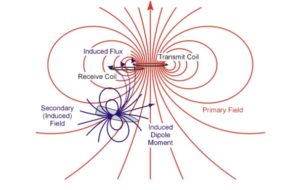Part 1 of this series addressed magnetometry. Another sensing technique used by archeologists and treasure hunters to find objects is electromagnetic induction (EMI or EM).
EMI sensing measures the change in mutual impedance between a pair of coils on or above the earth’s surface. Typical EMI instruments use two or more sets of coils, electrically connected and separated by a fixed distance. While EMI devices can simultaneously examine soil conditions and locate underground objects, they do not provide good depth information.
 In this EMI instrument conceptual operation, the primary fields (red) produce secondary fields (blue) that are detected by the receiver coil.
In this EMI instrument conceptual operation, the primary fields (red) produce secondary fields (blue) that are detected by the receiver coil.
An EMI meter measures the bulk averaged or apparent conductivity (ECa) of soils and earthen materials. Factors that influence the ECa of soils include the type and concentration of ions in solution, the amount and type of clays in the soil matrix, the volumetric water content, and the temperature and phase of the soil water. The increased presence of soluble salts, water, and/or clay contents in the soil will increase the ECa.
EMI can also be used as one of the remote sensing techniques for detecting and mapping buried waste materials in a geophysical survey system. In fact, a multi-receiver EMI sensor has been used as part of a non-invasive geophysical investigation to provide spatially comprehensive soil data for analyzing urban soil for pollutants. However, the author notes that a single geophysical method often lacks sufficient discriminating power to identify the various soil materials – a comment frequently found in many articles about ground analysis.
The next article in this series will explore ground penetrating radar (GPR), a technique often combined with either or EMI or magnetometry.
